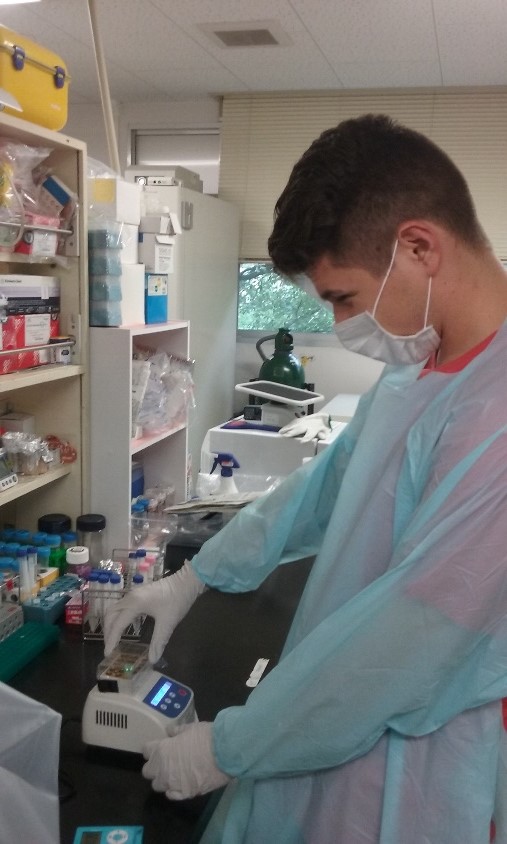Cody Ruiz Fourth blog post from Japan
Konnichi wa from the PRI – Week 4 (July 5 – 12)
The end of this most recent week marks one month in Japan for me! It’s been a great experience thus far, and I’m looking forward to the remaining six weeks. My labmates and I are making good progress, and I should be able to complete my training in the next month.
As a reminder, here’s the general research question: what are the differences in sperm protein production between the breeding and non-breeding seasons of the Japanese macaque? Such differences will provide significant insight into the genetic and molecular mechanisms underlying reproduction in primate males. This involves two methods: 1) RT – PCR, which I introduced in last week’s post, and 2) immunohistochemistry. The former is concerned with finding which genes are expressed during spermatogenesis. The latter, using fluorescently-tagged antibodies, helps visualize target proteins in the tissue itself. Together, these techniques provide an overall picture of how the Japanese macaque monkey regulates sperm production in both the breeding and non-breeding seasons.
This Week’s Progress
This past week in the laboratory, I learned and practiced the second technique – immunohistochemistry – by preparing, sectioning, and staining tissue samples with the guidance of my labmate, Ito-san.
Here I am using a microtome, a machine we used to cut 5 micrometer thin sections of tissue samples. That’s about 1/20th the thickness of a strand of hair!

After cutting the sample, we stained it with Hematoxylin-Eosin (HE) which helps visualize the various structures. We used marmoset tissue this week in our successful practice runs, so now we can prepare and stain our Japanese macaque samples!
Reverse Transcription
I was also able to start the first step of RT-PCR, which involves extracting RNA from a sample, then using the enzyme Reverse Transcriptase to turn it into DNA containing just the protein-coding sequences. We did this for the macaque samples, so now we can perform the second step, PCR, to see how much of our target genes are being expressed.
Here, I’m placing our RNA samples into a heat block which will help facilitate the Reverse Transcriptase. My lab mates warned me that the latex lab coat would feel like a sauna suit; more motivation to get the experiment done quickly!
Outside of the Lab
This week consisted of good deal of lab work, but I was able to do a few interesting things around Inuyama with some PRI friends, such as trying yakiniku (grilled meat) and karaage (marinated and lightly fried chicken). Teaser- next week our lab will go ukai fishing which will definitely yield some awesome pictures!

To celebrate Dr. Imamura’s recent grant award, our lab section went out for yakiniku. Everyone sits around a table which has a built in grill right in the middle, and the staff just brings out a never-ending supply of meats for you to grill and enjoy! Here’s Kitajima-san ferociously grilling some beef tongue.
Over the weekend, a few PRI friends and I went into town which culminated in a visit to a restaurant specializing in karaage. Here, Kawamoto-san and Shintaro-san help me decide which meal to get before entering the wonderfully-smelling karaage shop.
Next Week
Soon, I’ll be hitting my halfway point for my EAPSI fellowship! There’s still a lot of research left to do and a lot more of Japan to experience. Be sure to check in next week to learn more about molecular biology and a taste of Japanese culture, especially ukai! Lastly, I did manage to successfully get a haircut by myself this past week – a few key phrases like katto wa onegaishimasu (a haircut, please) and yoko mijikai (short on the sides) can go a long way! As always, thanks for reading, and until next week, matane!
This research is funded by the National Science Foundation East Asia and Pacific Summer Institutes for U.S. Graduate Students (EAPSI) in collaboration with the Japan Society for the Promotion of Science (JSPS).









